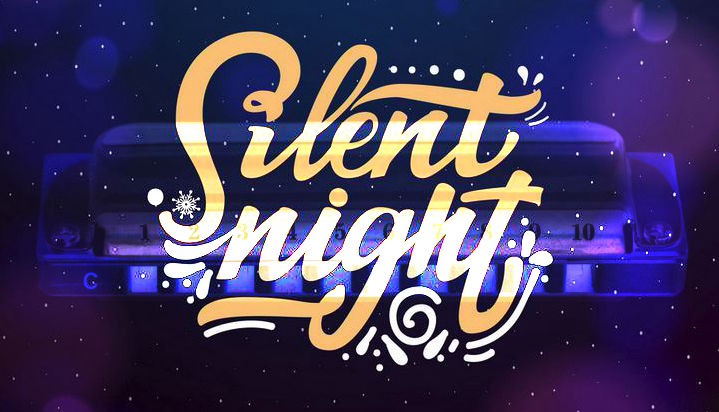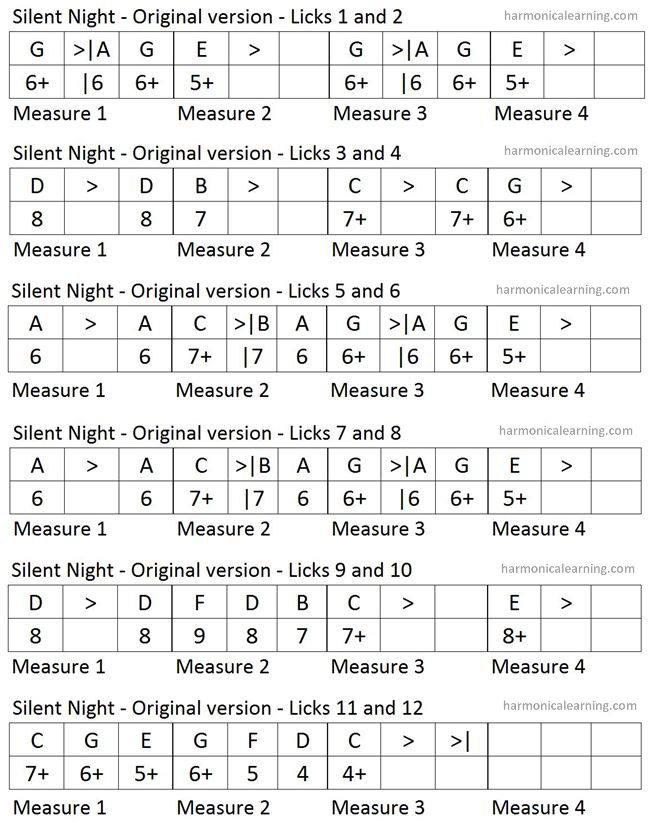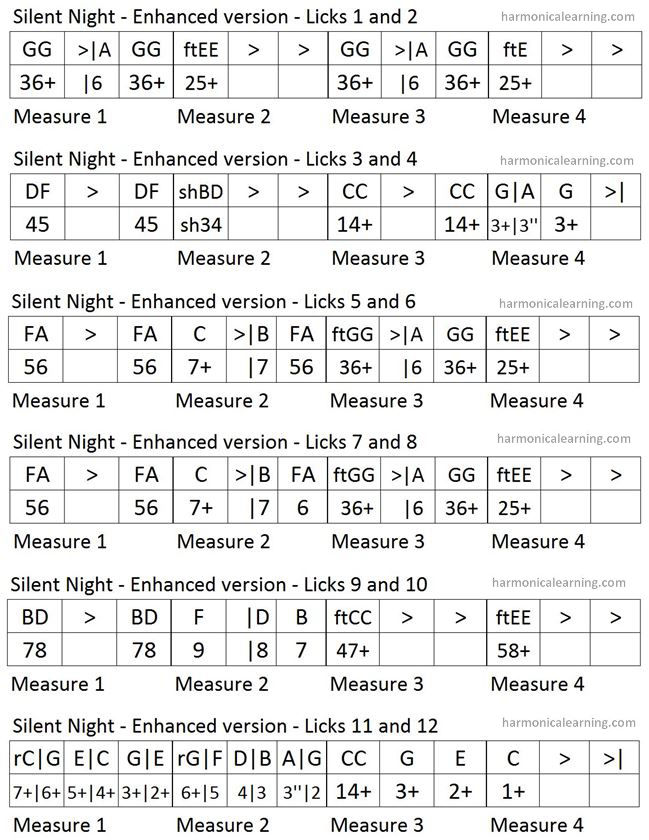
Among the Christmas songs I’ve known since childhood, Silent Night is my favorite, and I always like to play it on the harmonica. In this lesson, I’ll teach you all about this tune and give you the possibility to learn it with my play-along methodology. Below, you’ll find the videos, backing track, and tabs. Read up on this lesson and you’ll be the star at your next family Christmas party!
To play Silent Night, you’ll use a C harmonica to play in first position, using the entire note set of the C major scale. Where you can play these notes? Everything you’ll need can be found on holes 4 to 9. Here are the tabs for the C major scale on the center area of the instrument:
4+, 4, 5+, 4, 6+, 6, 7, 7+
For this particular tune, you’ll play higher on the harmonica up to hole 9 draw, where you can perform the F note.
Before practicing the licks that compose Silent Night, let’s have a look at the song chord progression. My intention is to give you something more than simply teaching you how to play the song – I’d like you to really understand what you’re practicing so that you can use the concepts you learn on your own and elaborate on them to produce new skills. As I used to explain to my harmonica students, whenever you approach studying a song, you can work in two ways: the first way is to just memorize the notes and play it, and the second is to analyze them to understand the rules they represent. If you work with the latter aptitude, you’ll not only studying a single song, but a great number of songs at the same time!
Let’s continue on with our lesson. Here are the chords for Silent Night:
C C C C G G C C
F F C C F F C C
G G C C C C C C
The chord progression is quite simple, and is a good example of what 90% of popular music is made of: three chords that represent the core of the song key. This song is in C major and the three most important chords are C, F, and G –the first, fourth, and fifth-degree chord respectively. We’re not going too deep in the topic today, but if you want, you can search on the internet for ‘major scale harmonization chords’, and you’ll learn that by giving a certain tonality, you’ll have a precise scale (set of notes to use) and set of chords that come from that scale harmonization. Believe me, these are elementary musical theory points that are worth learning. They’re like a booster in your car engine fuel, and will help you learn faster and better.
Going back to Silent Night, here are the notes to perform the melodies on the harmonica:
G A G E, G A G E
D D B, C C G
A A C, B A G, A G E
A A C, B A G, A G E
D D F D B C, E
C G E G F D C
And here, you’ll find the tabs with the harmonica holes:

Now, let’s analyze the licks. You’ll start on hole 6 blow and play note G, the fifth-degree of the below C major chord. The first lick ends on hole 5 blow with the note E, the third degree of the same chord. The E note is the second-most important of the tune, because it’s the one that determines the song major mode! Playing these two notes on the C chord is a safe way to perform – we call this ‘playing on the chords’, which means making melodies using notes that are part of the current chord in the harmonic progression.
The first lick is played twice. Then, when the harmony goes to the G major chord, you’ll play note D. What a coincidence – the D note is the fifth degree of the G major chord, as in the previous lick when the G note was for the C major chord. Tell your harmonica buddies that you’re starting to understand some core concepts about making music! What about note B on hole 7 draw? Make your reasoning and discover why this kind of song became really popular in the world – simplicity and established, easy-to-follow rules.
The third song section is where you play the note A on hole 6 draw on the F major chord, then go back home to the main chord, C major. The F to C chord progression is repeated, then the harmony goes to G and the melodies follow the movement, ending the song on the C major chord, on which you’ll play the song key note C. Practice the passage from hole 5+ to 8 slowly at first – this is a pretty difficult harmonica hole jump if you’re a beginner. If you like, you can try to play it with a glissando, blowing while sliding from one hole to the other and inverting the airflow as you reach hole 8.
And that’s Silent Night – a great example of simple and effective composition. Do you think the song is too easy for you? If so, I’ve prepared an enhanced version of it that you can try to perform and get back to me with! You can even make a recording and share it with your friends together with this lesson.
Here are the tabs for the enhanced version:

And now, some tips about this particular Silent Night harmonica version:
You’ll play double note combinations and split notes in particular octaves. For example, 36+ plays a G octave. The flutter tongue articulation is expressed with the ‘ft’ symbol which, together with the split notes, is a feature of the tongue blocking technique.
You’ll also need to bend hole 3 draw of a whole tone to play the A note, and you should be able to perform a glissando when playing the C note on hole 7+ and the G note on hole 6 blow. The last two licks are quite challenging – try to play them at the right tempo. As you’ll notice, I’ll make you play on the high harmonica holes too.
Now it’s time for you to practice the song on your harmonica! You’ll play it twice with the video lesson, then you’ll find my variation performed two times as well. Enjoy!
I hope you enjoyed this lesson, and I invite you to share it with your friends. Have a look at my online harmonica courses as well – you could find exactly what you need to unleash your harmonica potential!
If you want to get to know more about Silent Night, here’s some general information about the song:
“Stille Nacht, Heilige Nacht,” also known simply as Stille Nacht, is one of the most famous Christmas carols in the world. It’s of Austrian origin and has been translated into more than 300 languages and dialects. The song is known in Italy as “Astro del Ciel” with different lyrics; the English version, of course, is called “Silent Night.”
The words were written in 1816 by Salzburg priest Joseph Mohr, a parish assistant in the church of Mariapfarr in the Lungau, Salzburg region. He kept these words in a drawer, waiting to find someone who could put them to music. Two years later, he met Franz Xaver Gruber, an elementary school teacher in Arnsdorf and organist in Oberndorf originally from Upper Austria. It was Gruber who composed the music, which he played on Christmas Eve in 1818.
The territory had not been spared by the recent Napoleonic wars, and devastation and misery were everywhere. The verses of the young priest were hoped to be of comfort to the exhausted population. In Christmas 1816, they were only read, while two years later, they were also sung with the music that Gruber had composed. In fact, on 24 December 1818, Mohr asked Gruber to set to music the song he’d written for two solo voices, a choir, and the guitar. Gruber showed this score to Mohr, who immediately approved. It’s not known why this request was made; however, a traditional account reports that this happened because the organ of the church of San Nicola was broken – the bellows had been gnawed by mice and repair was impossible in such a short time (which would explain the use of the guitar).
The first public performance occurred on the night of 24 December 1818, during the Christmas Mass in the church of Saint Nicholas in Oberndorf, near Salzburg. The song was performed by its two authors, with Mohr singing the tenor part and accompanying with the guitar Gruber singing the bass part.
Share this page with your friends!